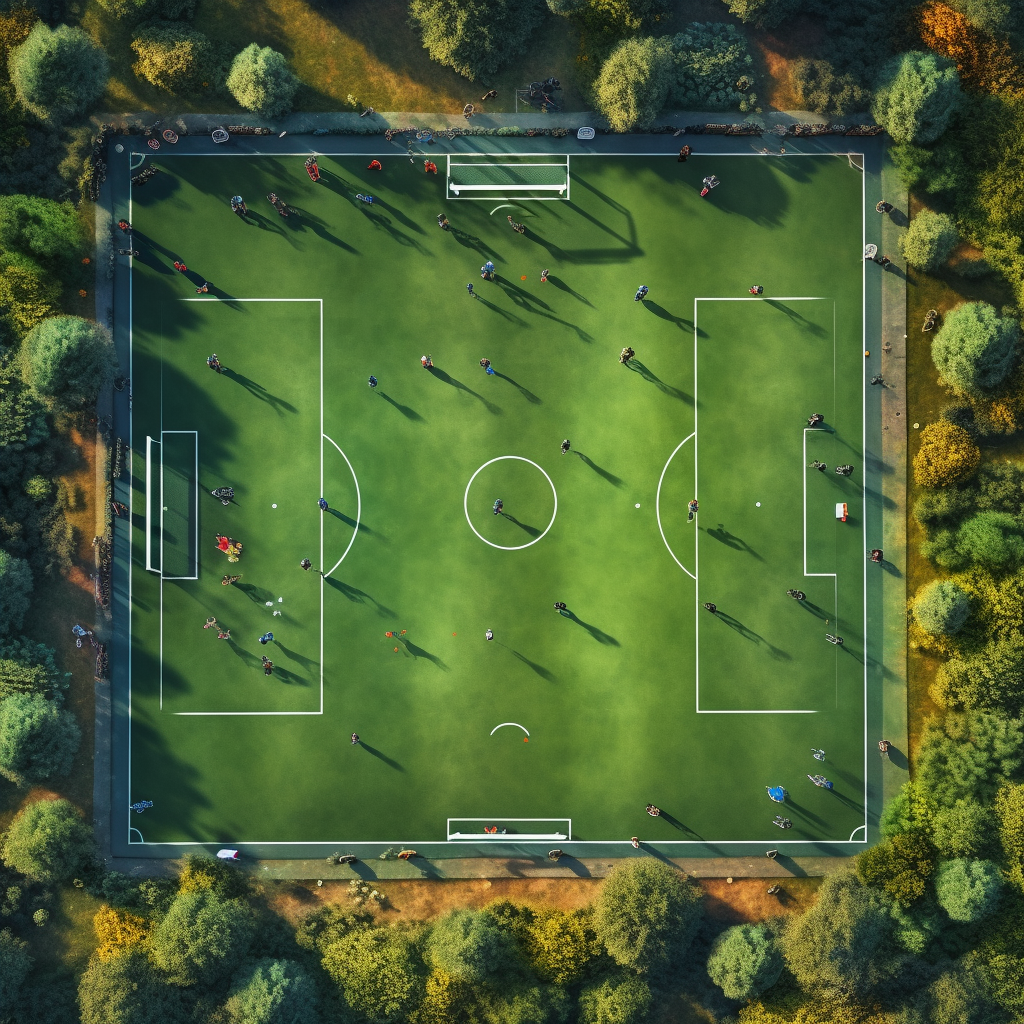Understanding Youth Soccer Field Dimensions
When it comes to youth soccer, having the right field dimensions is crucial for fair play, safety, and overall enjoyment of the game.
Accurate dimensions create an optimal playing environment for young athletes, ensuring a level playing field and promoting skill development.
The Importance of Soccer Field Dimensions
- Accurate dimensions on a soccer field are essential for fair play and safety. When the field is properly sized, it allows players to compete on an even playing field, eliminating any advantages or disadvantages caused by irregular dimensions.
- Field dimensions also have a significant impact on player development and tactical strategies. A well-sized field allows young players to develop their skills effectively, understanding the importance of spacing, positioning, and teamwork.
- Youth soccer is not just about playing the game; it plays a crucial role in promoting physical activity and teamwork among children. Having appropriate field dimensions ensures that young athletes have enough space to run, pass, and engage in the game actively.
Understanding the significance of proper field dimensions is the foundation for creating an enjoyable and productive youth soccer experience.
By providing young players with the right environment to learn and grow, we can foster their passion for the game while promoting values such as fair play and teamwork.
Official Youth Soccer Field Dimensions
When it comes to youth soccer, having the right field dimensions is crucial for fair play and safety. The size of the field impacts not only the players’ development but also the tactical strategies they can employ during a game. Additionally, youth soccer plays a vital role in promoting physical activity and teamwork among young athletes.
Field Size for U6 and U8 Age Groups
For players in the U6 and U8 age groups, it is recommended to have smaller field dimensions to cater to their abilities. The dimensions for these age groups typically range from 25 to 35 yards wide (22.86 to 32 metres) and 40 to 55 yards long (36.5 to 45.72 metres). These smaller fields allow young players to better engage with the game, develop their skills, and understand the basic concepts of soccer.
The reasoning behind these dimensions is to create an environment that matches the physical capabilities and attention spans of young children. Smaller fields ensure that players can cover the entire field without feeling overwhelmed, enabling them to participate actively and enjoy the game.
Field Size for U10 and U12 Age Groups
As players progress in skill and physical capabilities, the field dimensions for the U10 and U12 age groups increase. The recommended dimensions for these age groups typically range from 45 to 60 yards wide (41.14 to 54.86 metres) and 70 to 80 yards long (64 to 73.15 metres). These slightly larger fields allow for more complex tactics and strategies to be implemented during matches.
The adjustments made in field size reflect the players’ improved abilities in terms of speed, control, and understanding of the game. With larger fields, players have more space to showcase their skills, make precise passes, and execute strategic plays.
Field Size for U14 and Above Age Groups
For players in the U14 age group and above, the field dimensions align with professional standards to prepare them for higher levels of competition. The recommended dimensions for these age groups typically match those of adult soccer fields, which are approximately 70 to 80 yards wide (64 to 73.15 metres) and 110 to 120 yards long (100.5 to 109.7 metres).
By playing on fields that mirror professional standards, young players can better develop their skills and adapt to the demands of competitive soccer. These larger fields require players to cover more ground, make quicker decisions, and showcase their abilities in a challenging environment.
It’s important to note that while the dimensions for each age group provide a general guideline, variations may exist depending on regional or organizational regulations. Local leagues and governing bodies may have specific requirements that teams must adhere to when it comes to field dimensions.
To ensure fair play and a positive soccer experience for young athletes, it’s essential for coaches, parents, and administrators to familiarize themselves with the recommended field dimensions for each age group. By providing appropriate field sizes, we can create an environment where players can thrive, learn, and enjoy the beautiful game of soccer.

Considerations for Soccer Field Layout
When it comes to youth soccer fields, proper layout and markings play a crucial role in ensuring fair play, safety, and an enjoyable experience for all involved. In this section, we will explore the essential considerations for field layout that contribute to a well-organized and functional playing environment.
Regulation Markings on the Field
The importance of properly marked lines on a youth soccer field cannot be overstated. These markings serve multiple purposes, including defining the boundaries of the field, indicating different areas of play, and facilitating fair gameplay. It is essential to adhere to the required regulation markings to ensure consistency across games and promote a level playing field.
- Center Circle: The center circle is a key marking that signifies the starting point of the game. It also plays a role in restarts, such as kick-offs.
- Penalty Areas: The penalty areas, also known as the 18-yard boxes, are designated areas where fouls can result in penalty kicks. These markings help referees make accurate decisions during matches.
- Goal Areas: The goal areas, or six-yard boxes, are located within the penalty areas and serve as zones from which goal kicks are taken. They also provide guidelines for positioning players during set pieces.
- Touchlines and Goal lines: The touchlines (sidelines) and goal lines define the boundaries of the field. They ensure that the game stays within a specific area and help determine when the ball is out of play.
Goal Size and Placement
Determining the appropriate size and placement of goals on youth soccer fields is crucial for player safety and fair competition. The dimensions of the goals vary depending on the age group, ensuring that they are suitable for the physical capabilities of the players.
- U6 and U8 Age Groups: For younger players in the U6 and U8 age groups, smaller goals measuring approximately 4 feet high and 6 feet wide are recommended. Placing these goals closer together encourages more engagement and participation from all players.
- U10 and U12 Age Groups: As players progress in skill and physical capabilities, the goal size increases to approximately 6.5 feet high and 18.5 feet wide for the U10 and U12 age groups. The increased size allows for more challenging gameplay and encourages skill development.
- U14 and Above Age Groups: In line with professional standards, the goal size for U14 and above age groups is 8 feet high and 24 feet wide. These dimensions prepare players for higher levels of competition and align with the standard goals used in senior soccer.
It’s important to note that goalposts should be securely anchored to prevent accidents or injuries during play. Safety considerations should always be a top priority when setting up goals on youth soccer fields.
![]()
Spectator Areas and Facilities
A positive game-day experience goes beyond the players on the field; it extends to spectators, families, and fans as well. Designated spectator areas and facilities contribute to creating a welcoming and enjoyable environment for everyone involved.
- Spectator Areas: Providing designated spectator areas, such as bleachers or designated standing areas, ensures that spectators have a clear view of the game while staying safely away from the playing area.
- Amenities: Facilities like restrooms, seating areas, and even concession stands enhance the overall experience for players, families, and fans. These amenities contribute to the comfort and convenience of those attending games and help create a sense of community.
By considering the needs of spectators and providing appropriate facilities, youth soccer organizations can foster a supportive and enjoyable atmosphere that encourages continued participation and enthusiasm for the sport.
Adapting Field Dimensions for Limited Space
When it comes to youth soccer, creating a safe and enjoyable playing environment is essential. However, not all soccer fields have the luxury of vast open spaces. In urban areas or schools with limited space, adapting field dimensions becomes crucial to ensure that young players can still experience the joy of the game. Let’s explore some strategies for adapting field dimensions in these situations.
Small-Sided Games and Modified Field Sizes
One effective approach to overcome limited space challenges is by implementing small-sided games. These games involve fewer players on a smaller field, allowing for more touches on the ball and increased involvement in the game. Small-sided games have numerous benefits for player development:
- Improved technical skills: With more opportunities to touch the ball and make decisions, players can enhance their dribbling, passing, and shooting abilities.
- Enhanced tactical understanding: The smaller field size encourages players to develop their spatial awareness, decision-making, and positioning.
- Increased fitness levels: The reduced space leads to higher intensity and more frequent changes in direction, contributing to improved cardiovascular endurance.
To accommodate small-sided games in limited spaces, field dimensions can be modified. Here are some considerations:
- Reduced field length and width: Decreasing the overall dimensions of the field allows for a more compact playing area suitable for small-sided games. Different age groups may require varying adjustments.
- Smaller goals: Scaling down the size of the goals ensures that they are proportionate to the modified field size. This helps maintain an appropriate level of challenge for young players.
By adapting field dimensions for small-sided games, coaches and organizers can create an environment where young players can thrive and enjoy the beautiful game.
Alternative Field Surfaces
Another solution to accommodate limited space is to explore non-traditional playing surfaces. Artificial turf and futsal courts offer viable alternatives that can maximize the use of available space while providing a high-quality playing experience.
Artificial turf has gained popularity in recent years due to its durability, low maintenance requirements, and ability to withstand heavy use. It provides a consistent playing surface that allows for fast-paced gameplay and reduces the risk of injuries caused by uneven terrain.
Futsal courts, on the other hand, are specifically designed for small-sided games. These hard-court surfaces feature boundary lines and smaller goals, making them ideal for fast-paced, skill-focused play. Futsal enhances players’ close control, quick thinking, and technical skills.
When considering alternative field surfaces, it’s important to weigh the advantages against any potential drawbacks. Factors such as cost, climate suitability, and the specific needs of the players should be taken into account.
Ultimately, adapting field dimensions and exploring alternative surfaces can ensure that youth soccer remains accessible and enjoyable even in limited spaces. By embracing these adaptations, we can continue to foster a love for the game and provide young players with valuable opportunities for growth.

Safety Considerations on Youth Soccer Fields
Injury Prevention Measures
When it comes to youth soccer, safety should always be a top priority. By implementing proper injury prevention measures, we can ensure that players can enjoy the game while minimizing the risk of accidents and injuries.
- Proper field maintenance: Maintaining the soccer field is crucial for player safety. Regularly inspecting the field for any hazards such as uneven surfaces, debris, or holes can help prevent trips, falls, and ankle injuries.
- Adequate padding: Installing padding around posts, fences, and other potential collision points can significantly reduce the risk of severe injuries. This includes using padded goalposts and ensuring that any hard surfaces near the field are properly cushioned.
- Goalpost anchoring: Securing the goalposts firmly to the ground is essential to prevent them from tipping over during play. Unanchored goals pose a significant danger and have led to tragic accidents in the past.
In addition to these physical safety measures, it’s important to emphasize the importance of player education on safe play and fair sportsmanship. Coaches, parents, and officials should actively promote proper techniques, such as tackling safely and avoiding dangerous plays. By educating young players on injury prevention strategies and fostering a culture of respect on the field, we can create a safer environment for everyone involved.
Emergency Preparedness
While we strive to prevent injuries on youth soccer fields, it’s essential to be prepared for any unexpected situations that may arise. Establishing emergency action plans ensures that appropriate steps are taken promptly in case of accidents or medical emergencies.
Here are some guidelines to consider when creating emergency action plans for youth soccer fields:
- Clear communication: Coaches, officials, and parents should have a clear understanding of their roles and responsibilities during emergencies. Designate specific individuals to call for medical assistance or handle other necessary tasks.
- Accessible first aid kits: Ensure that well-stocked first aid kits are readily available on the field. These kits should include essentials such as bandages, antiseptic wipes, ice packs, and any necessary medications for players with pre-existing conditions.
- Communication with local authorities: Establish contact with local emergency services and provide them with relevant information about the field’s location. This will help expedite response times in case of emergencies.
Remember, emergency preparedness is a collaborative effort involving coaches, officials, and parents. By working together, we can ensure the safety and well-being of young soccer players.
Best Practices for Field Setup and Maintenance
Field Preparation Checklist
Before every match, it’s essential to properly set up the youth soccer field to ensure a fair and safe game. Here is a step-by-step checklist to guide you through the process:
- Inspect the field: Walk around the field and check for any hazards such as rocks, holes, or debris. Remove any obstacles that could pose a risk to players.
- Mark the lines: Use appropriate field marking equipment to accurately mark the boundary lines, goal lines, center circle, penalty areas, and goal areas. Double-check the measurements to ensure they align with the recommended dimensions for the specific age group.
- Set up goals: Place the goalposts securely in position at each end of the field. Ensure they are stable and won’t topple over during play. Also, make sure the nets are properly attached to the posts.
- Check field conditions: Examine the playing surface for any uneven areas, divots, or excessive wear. Fill in any holes and level out uneven patches to provide a smoother playing experience.
- Secure corner flags: Install corner flags at each corner of the field. They help players and referees identify the boundaries during gameplay.
- Prepare team benches: Set up designated areas for teams to sit along the sidelines. Ensure these areas are safely distanced from the playing area and have enough seating for players and coaches.
- Inspect equipment: Verify that all necessary equipment such as balls, cones, and first aid kits are readily available on the sidelines.
Routine Field Maintenance
To maintain a safe and enjoyable playing environment throughout the season, regular field maintenance is crucial. Here are some tips for routine field maintenance:
- Mow the grass: Keep the grass at an appropriate height depending on the climate and growing conditions. Regular mowing helps prevent the grass from becoming too long, which can affect gameplay and ball movement.
- Water the field: Adequate watering is essential to keep the grass healthy and prevent it from drying out. Monitor weather conditions and adjust watering accordingly to ensure optimal hydration for the turf.
- Repair damaged areas: Inspect the field regularly for any damaged or worn-out sections. Repair divots, bare spots, or uneven areas to maintain a level playing surface and reduce the risk of player injuries.
- Aerate the soil: Periodically aerate the field to improve drainage and promote healthy root growth. This process helps prevent waterlogging and compaction, which can impact the turf’s overall quality.
- Fertilize appropriately: Consult with turf experts or follow recommended fertilization schedules to provide essential nutrients for grass growth. Proper fertilization enhances the field’s resilience and appearance.
- Weed control: Implement effective weed control measures to prevent invasive plants from taking over the field. Regularly inspect and remove any weeds to maintain a clean and uniform playing surface.
Off-Season Field Care
During off-season periods when the field is not in use, it’s essential to implement specific maintenance practices to ensure its long-term health. Here are some methods to consider:
- Prevent weed growth: Apply pre-emergent herbicides before weed seeds germinate to minimize weed growth during dormant periods. This proactive measure reduces the need for excessive weed control efforts later on.
- Optimize drainage: Evaluate the field’s drainage system and make any necessary improvements during the off-season. Proper drainage helps prevent water accumulation and promotes healthy turf growth.
- Improve soil health: Conduct soil tests to assess its pH levels and nutrient content. Based on the results, amend the soil with organic matter or appropriate fertilizers to enhance its quality and provide a favorable environment for grass growth.
- Overseed as needed: If the turf shows signs of thinning or bare patches, overseeding can help rejuvenate its density. Choose grass seed varieties suitable for the specific climate and field conditions.
- Protect high-traffic areas: Identify areas that receive the most foot traffic during regular gameplay. Implement measures such as temporary fencing or signage to prevent excessive wear and compaction in these zones.
By following these best practices for field setup and maintenance, you can create a safe, well-maintained playing surface that enhances the youth soccer experience for players, coaches, and spectators alike.

Enhancing Youth Soccer with Proper Field Dimensions
The role of field dimensions in youth soccer is crucial to creating an optimal playing environment for young athletes. By ensuring that soccer fields have appropriate dimensions, we can enhance player development and the overall soccer experience. Let’s take a closer look at why proper field dimensions matter and how they contribute to promoting a love for the game.
The Role of Field Dimensions in Youth Soccer
Having accurate dimensions for youth soccer fields is essential for fair play and safety. When the field dimensions are precise, it ensures that all teams have an equal opportunity to showcase their skills and strategies. Additionally, properly sized fields help prevent overcrowding and reduce the risk of collisions or injuries among players.
Field dimensions also play a significant role in player development. Young athletes need sufficient space to learn and execute different techniques effectively. With appropriate field dimensions, players can develop their ball control, passing accuracy, and spatial awareness. Moreover, it allows coaches to implement tactical strategies that align with the age and skill level of the players.
The overall soccer experience is greatly influenced by properly sized fields. When players have enough room to showcase their abilities, it boosts their confidence and enjoyment of the game. Playing on fields that adhere to official dimensions also helps young athletes transition smoothly to higher levels of competition in the future.
Promoting a Love for the Game
In youth soccer, it is essential to prioritize enjoyment and inclusivity over winning at all costs. By emphasizing the love for the game, we create an environment where young athletes can thrive both on and off the field. Parents, coaches, and administrators play a vital role in fostering this positive sporting atmosphere.
Encouraging readers to prioritize youth soccer’s enjoyment and inclusivity means focusing on the holistic development of players. It involves nurturing their passion for the sport, promoting fair play, and instilling values such as teamwork, respect, and sportsmanship. When young athletes feel supported and valued, it enhances their overall soccer experience and encourages long-term participation.
Parents, as well as coaches and administrators, have the responsibility to create a positive sporting environment. This includes fostering a culture of inclusivity, providing constructive feedback, and promoting a healthy balance between competition and fun. By prioritizing the well-being and enjoyment of young athletes, we can ensure that soccer remains a lifelong passion for them.
In conclusion, having appropriate dimensions for youth soccer fields is vital for player development and the overall soccer experience. Proper field dimensions contribute to fair play, safety, and the promotion of a love for the game. By ensuring that fields are accurately sized and creating a positive sporting environment, we can nurture young athletes’ passion for soccer and help them reach their full potential.




Leave a Reply